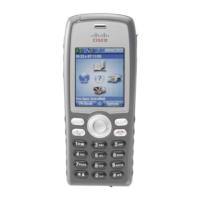
Do you have a question about the Cisco 7925G Series and is the answer not in the manual?
| Wireless | IEEE 802.11a/b/g |
|---|---|
| Headset Jack | 2.5 mm |
| Bluetooth | No |
| Frequency Band | 2.4 GHz, 5 GHz |
| Display | 2.0 in. TFT color display, 176 x 220 pixels |
| Battery | Lithium-ion |
| Audio | G.711, G.729 |
| Security | WPA, WPA2 |
| Voice Codecs | G.711, G.729, G.722 |
| Battery Life | 8 hours talk time |
| Operating Temperature | 32°F to 104°F (0°C to 40°C) |
| Compliance | FCC |
Key procedures for site survey and RF validation to ensure optimal wireless LAN performance.
Details on call control protocols and supported communication protocols for the IP phone.
Overview of available phone models, regulatory domains, and localization support.
Information on radio frequencies, data rates, receiver sensitivity, and Bluetooth capabilities.
Supported wireless security modes including WPA, WPA2, and EAP types.
Configuration steps for EAP-FAST and EAP-TLS for secure wireless authentication.
Details on Protected Extensible Authentication Protocol (PEAP) and CCKM for fast roaming.
Security features supporting voice communications including certificates and encryption.
Optimizing battery life and ensuring voice quality through QoS and power saving protocols.
Implementing Call Admission Control (CAC) for managing voice traffic and bandwidth.
Strategies for seamless roaming, interband roaming, and channel planning.
Guidelines for ensuring adequate signal strength and coverage for VoWLAN service.
Recommendations for setting data rates to optimize capacity, range, and performance.
Creating and applying phone button and softkey templates for device customization.
Configuring security profiles and managing G.722 codec advertisement.
Detailed configuration options available for the Cisco Unified Wireless IP Phone 7925G Series.
Configuring SSID and WLAN settings for optimal voice client connectivity.
Optimizing 802.11 network parameters for 5 GHz and 2.4 GHz bands.
Setting EDCA parameters for voice optimization and configuring DFS for 802.11h.
Configuration of QoS Basic Service Set (QBSS) for managing channel access.
Methods for configuring phones via keypad, web interface, and Wavelink Avalanche.
Procedure for installing client and server certificates for secure authentication.
Using templates and bulk deployment utilities for efficient phone provisioning.
Managing mobile devices and configuring phones using Wavelink Avalanche.
Information on supporting XML and Java MIDP applications for IP phone services.
Monitoring call statistics, stream data, and network performance metrics.
Obtaining phone logs and configuring trace levels for troubleshooting.
Performing hardware diagnostics and recovering phone firmware.
